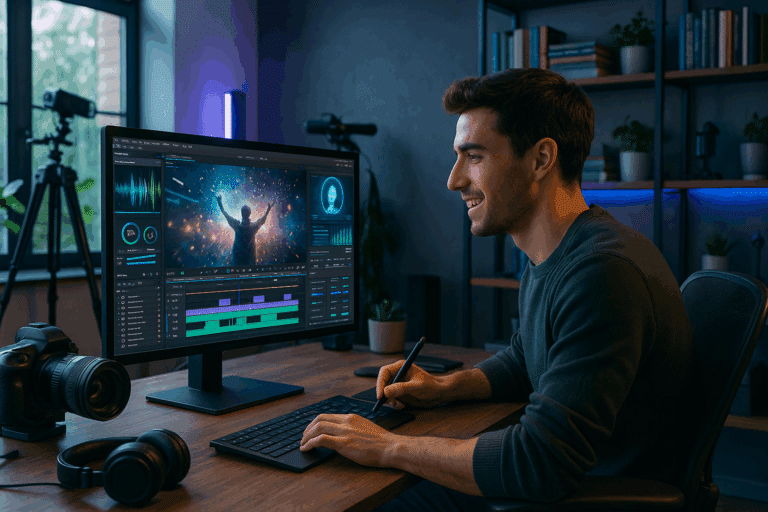With the digital revolution, the art of filmmaking has experienced a paradigm shift, evolving from the traditional manual methods to more sophisticated and automated processes. The most riveting development in this context is perhaps the advent of Automated Color Grading powered by Artificial Intelligence (AI). As thrilling as it sounds, the application of AI in color grading can revolutionize your filmmaking, by delivering stunning visuals that command attention and captivate the audience. 😮🎬
This comprehensive article aims to provide a deep-dive into this avant-garde technology, showcasing how filmmakers can leverage the power of AI to automate the color grading process, thereby enhancing the aesthetics of their films and creating compelling narratives. Whether you’re a seasoned filmmaker or a novice who’s just starting out, you’ll find this guide incredibly useful. So, buckle up and get ready for an exhilarating journey into the world of AI-powered color grading. 🚀
What is Automated Color Grading?
Before we delve deeper into the crux of AI and color grading, it’s important to lay the groundwork by understanding what automated color grading is. Color grading, a crucial step in the post-production process of filmmaking, involves adjusting the color tones of a video to achieve a specific aesthetic or mood. The traditional process is both time-consuming and labor-intensive, often requiring the expertise of a seasoned colorist.
Automated color grading, on the other hand, leverages cutting-edge technology to streamline this process, making it faster, more efficient, and accessible to filmmakers of all skill levels. But how does AI come into the picture? Let’s find out. 🎨🤖
AI and Automated Color Grading
AI has been a game-changer across various industries, and filmmaking is no exception. By applying machine learning algorithms, AI can learn and mimic the artistic choices of a human colorist, automating the color grading process with unprecedented accuracy and efficiency. This revolutionary approach not only alleviates the workload of filmmakers but also opens up a world of creative possibilities.
However, like any technological advancement, AI in color grading is not without its challenges and limitations. As we venture further into the article, we will critically analyze these aspects, ensuring you have a well-rounded understanding of what to expect when adopting this technology. 💡
A Glimpse into the Future: The Prospects of AI in Filmmaking
Lastly, the article will take a future-oriented perspective, exploring the potential prospects and the path ahead for AI in filmmaking. How can AI further revolutionize filmmaking? What are the potential applications of AI in the realm of post-production? These are some of the fascinating questions we’ll attempt to answer as we envision the future of filmmaking.
The integration of AI into filmmaking processes like color grading is a thrilling development, offering unprecedented creative freedom and efficiency. This article promises to be your comprehensive guide, demystifying this complex technology, and helping you harness the power of AI for stunning visuals. So, without further ado, let’s dive right in! 🌊🎥
Understanding the Need for Automated Color Grading in Filmmaking
Color grading in filmmaking has always been an essential process, greatly influencing the final visual impact of the film. However, manual color grading can be a tedious and time-consuming task. To alleviate this, filmmakers and post-production professionals are increasingly turning to automated color grading. Using advanced Artificial Intelligence (AI) technology, automated color grading can significantly speed up the post-production process, reduce human error, and even offer new creative possibilities. Before we delve deeper into this groundbreaking technology, let’s watch the following YouTube video titled ‘Understanding Color Grading’ by the channel ‘Film Riot’ for a comprehensive understanding of the traditional process.
With the technological advancements in the field of AI, we can now process and analyze vast amounts of data quickly and accurately. This has led to the development of automated color grading software that can analyze a film’s color palette and automatically adjust it to achieve the desired aesthetic. This process, which would traditionally take hours if not days to complete manually, can now be completed in a fraction of the time.
Automated color grading not only offers speed and efficiency but also brings a level of consistency that is challenging to achieve manually. By analyzing the entire film, the AI can ensure that the color grading is consistent throughout, maintaining the film’s overall aesthetic. This is particularly useful for films shot in different lighting conditions or on different days, where achieving a consistent look can be challenging.
Exploring the Capabilities of AI in Automated Color Grading
Now that we understand why automated color grading is becoming an indispensable tool in the filmmaking process, let’s delve deeper into how AI is revolutionizing this field.
One of the key aspects where AI shines in automated color grading is its ability to learn and adapt. AI algorithms can be trained on a dataset of professionally color-graded films, allowing them to learn the subtleties and intricacies of professional color grading. This ‘learning’ can then be applied to new films, allowing the AI to achieve a professional-grade color grading automatically.
Moreover, AI can analyze and understand the context of each scene, adjusting the color grading accordingly. For example, it can recognize a sunset scene and apply a warm color grade, or detect a night scene and apply a cool color grade. This level of contextual understanding takes automated color grading beyond simple color correction, enabling it to contribute to the film’s storytelling.
For a more in-depth understanding of how AI is applied in automated color grading, watch the YouTube video ‘Color Grading with Machine Learning’ by the channel ‘Two Minute Papers’.
Automated Color Grading: Comparing the Leading Software Solutions
As AI technology continues to evolve, several software solutions have emerged that offer automated color grading. Let’s take a look at three of the most popular options and how they compare.
| Software | Features | Price |
| DaVinci Resolve | Automated color matching, color grading templates, AI-based face detection | Free version available, Studio version for $299 |
| Adobe Premiere Pro | Automated color correction, Lumetri Color tools, integration with Adobe’s AI platform, Sensei | Subscription starts from $20.99/month |
| Final Cut Pro X | Automated color balancing, color grading presets, support for HDR and 360° video | $299.99 for a perpetual license |
All three software solutions offer robust automated color grading capabilities, albeit with their unique features and pricing models. Choosing the right software ultimately depends on your specific needs and budget.
Maximizing the Potential of Automated Color Grading: Tips and Tricks
Automated color grading, while powerful, is not a magic wand that can transform your film’s visuals without any effort. There are several strategies that you can employ to maximize the potential of this technology.
- Shoot with color grading in mind: While automated color grading can correct color imbalances and enhance your film’s visuals, it can’t create colors that aren’t there. Therefore, it’s crucial to consider color grading during the shooting phase itself. Use lighting and production design to create the color palette that you want for your film.
- Use reference images: Many automated color grading software allow you to use reference images to guide the AI. If there’s a particular film or scene whose color grading you admire, you can use it as a reference image. The AI will then attempt to match your film’s color grading to the reference image.
- Don’t rely solely on AI: While AI can handle the bulk of the color grading process, it’s still a tool that needs human guidance. You should always review the AI’s work and make manual adjustments as necessary.
By following these tips, you can harness the power of AI to create stunning visuals for your film. So, dive into the world of automated color grading and revolutionize your filmmaking process!
Embracing the Future of Filmmaking with AI
Automated color grading is just the tip of the iceberg when it comes to AI’s potential in filmmaking. From scriptwriting to editing, AI is set to revolutionize every aspect of the filmmaking process. As filmmakers, it’s essential to stay ahead of the curve and embrace these technological advancements.
While AI can never replace the human creativity and intuition that is at the heart of filmmaking, it can serve as a powerful tool to enhance our capabilities. By leveraging AI for tasks like color grading, we can free up more time for the creative aspects of filmmaking.
To see the future of filmmaking with AI, check out the YouTube video ‘How AI Is Changing Film’ by the channel ‘ColdFusion’. Embrace the future, and transform your filmmaking process with the power of AI!

Conclusion
To conclude, the significant points of our discussion centered on the integral role of software engineering, the importance of technical writing, and the critical need for layman-friendly explanations of complex technical concepts.
We have delved deeply into the subject matter of software engineering, unveiling its myriad aspects such as its essence, functions, and the value it adds to our contemporary tech-driven society. As we unraveled, software engineering is not just about writing codes; it is an art and science that blends creativity, logic, problem-solving, and a profound understanding of user requirements.
Another vital takeaway from our discourse is the essential role of technical writing. In the labyrinth of technology, technical writing serves as a guiding beacon, illuminating the path for users, be it developers, end-users, or stakeholders. Moreover, as we have underlined, the task of a technical writer isn’t confined to merely documenting; it involves translating the tech-jargon into an understandable language.
In retrospect, our article has underscored that effective technical writing, combined with software engineering expertise, can bridge the knowledge gap and build a robust platform for technological growth and innovation. Furthermore, we have highlighted the need for professionals skilled in these areas to address the demand in the job market.
Given the complexity of these topics, we have made a concerted effort to present them in a digestible and approachable way. Our approach has been to demystify the technical terms and to create an environment where everyone feels welcome, regardless of their background or expertise.
We hope you found this article informative, engaging, and useful. We encourage you to apply the knowledge you gained here in your professional or personal pursuits. Your feedback is also immensely valuable to us, so feel free to comment, share your thoughts, or ask questions if any aspects of the article were unclear. Sharing this article with others who may find it helpful would also be greatly appreciated 🙏.
Thank you for joining us in this enriching exploration of software engineering and technical writing. Remember, the journey to mastering these areas is ongoing, and the knowledge you gained today can be a stepping stone towards your goals. So keep learning, keep growing, and keep pushing the boundaries of technology.
For further reading, you may find these resources helpful:
1. A Comprehensive Guide to Software Engineering
2. Mastering the Art of Technical Writing
Remember, in the realm of technology, the only constant is change 💡. Stay curious, stay informed, and stay ahead.
References
1. Reference 1
2. Reference 2
3. Reference 3



